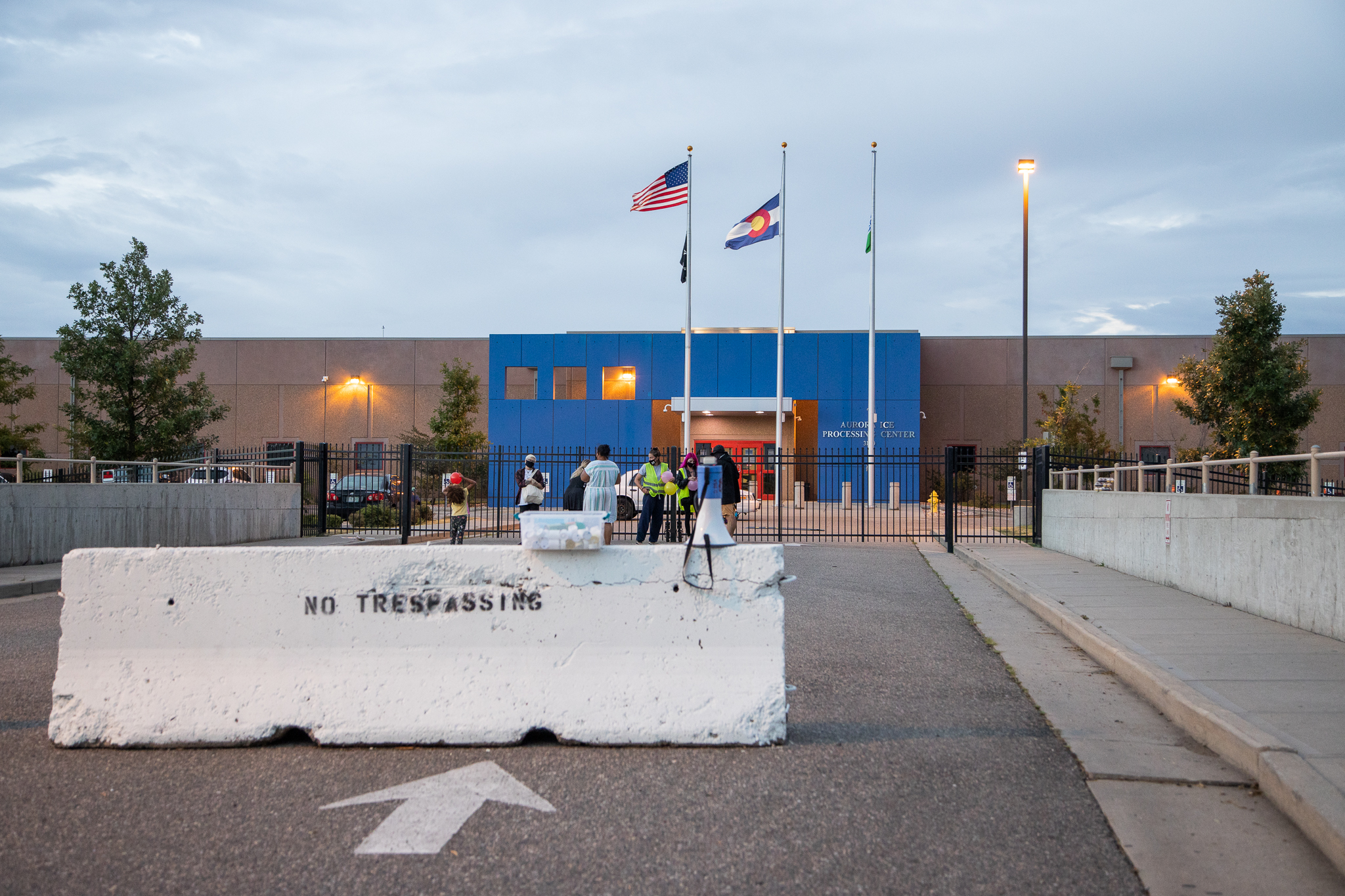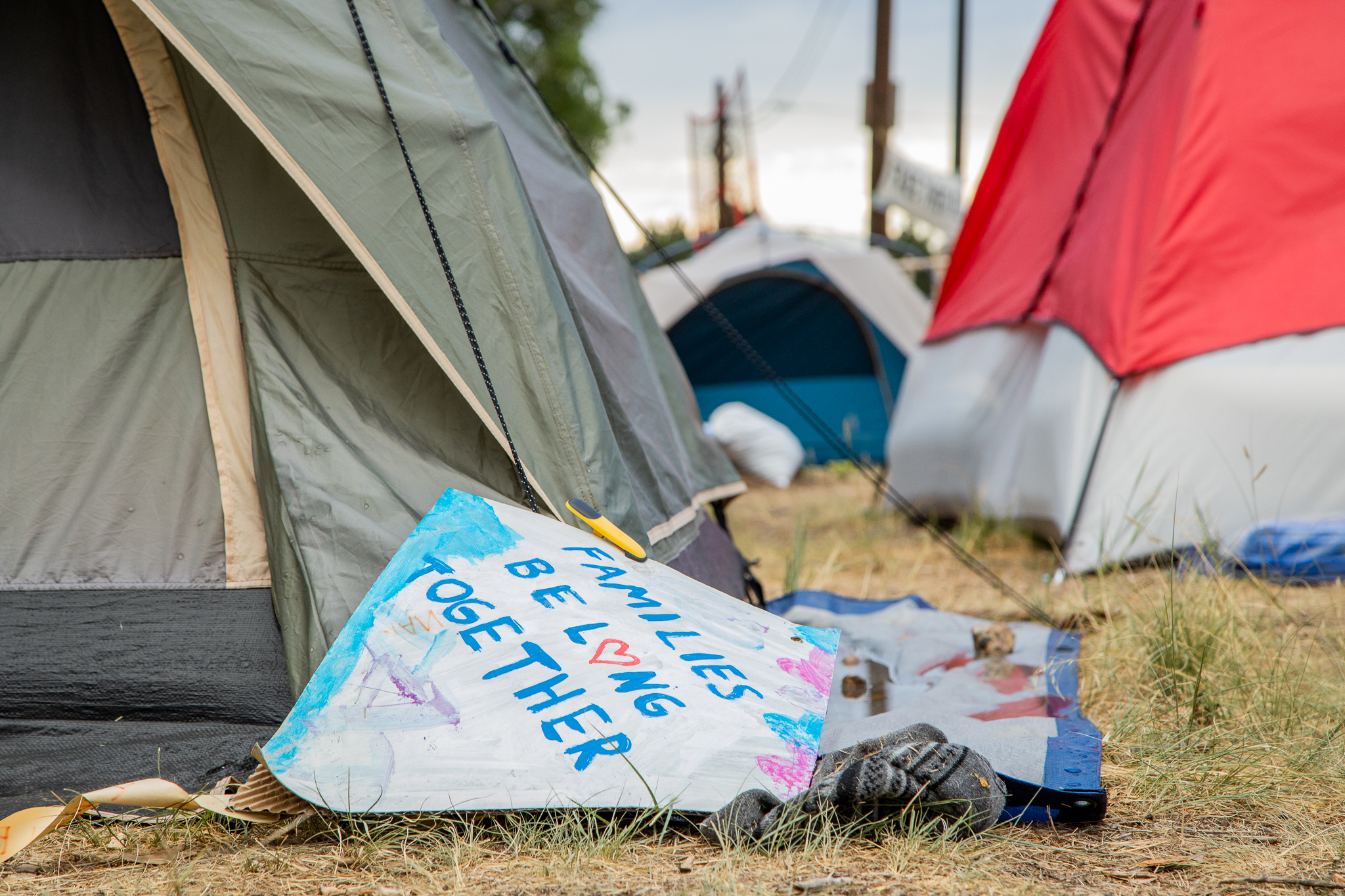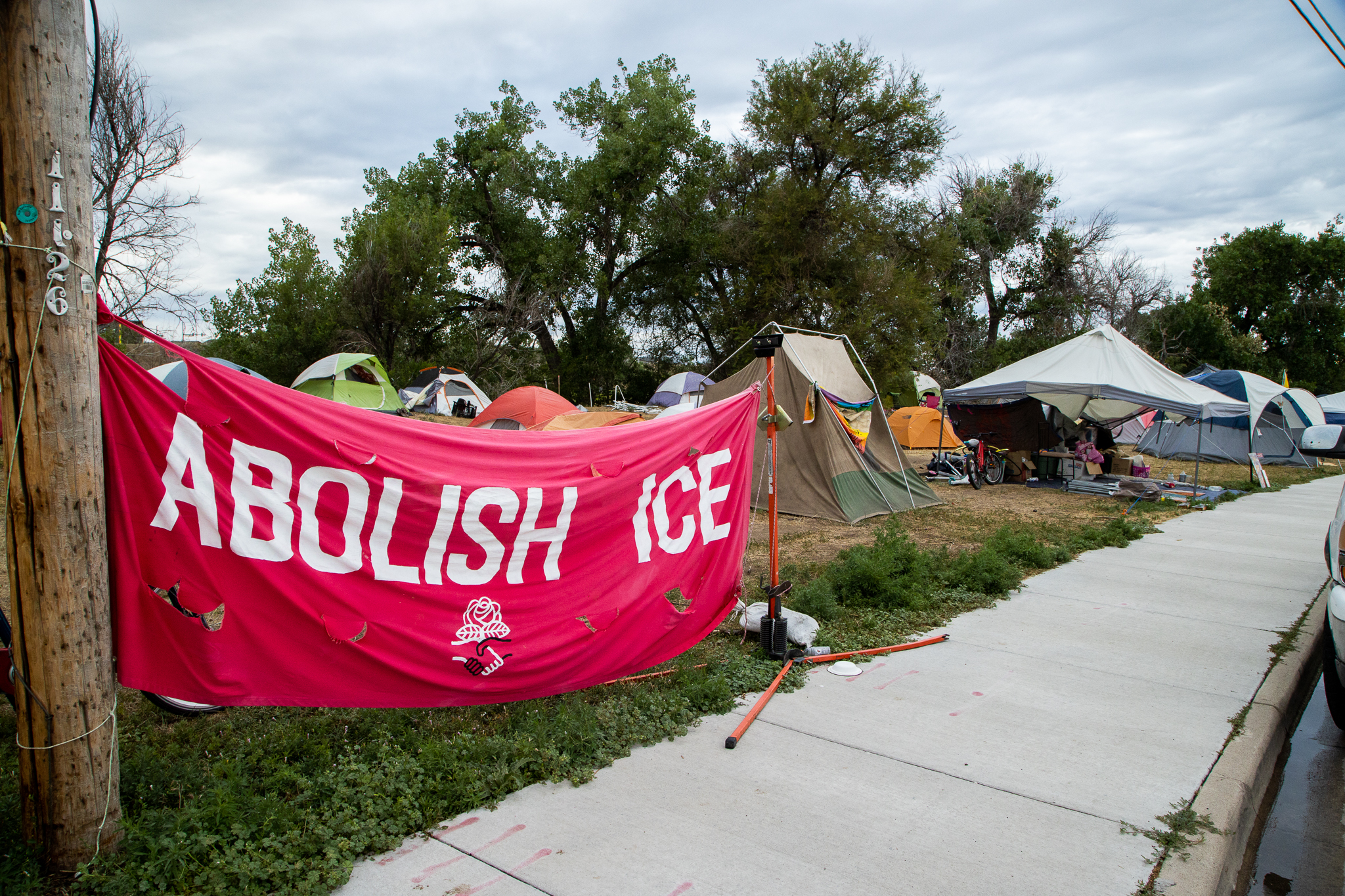For more than two months, protesters have camped outside a detention center in Aurora. They are operating under a campaign to #FreeThemAll and their efforts have focused national attention toward the Colorado facility and to a litany of serious problems.
The facility in Aurora, owned by GEO Group, signed a contract worth more than $300 million with Immigrations Custom and Enforcement (ICE) in 2011 to hold ICE detainees. GEO is a Florida-based company that has operated the detention center for more than three decades, although not without some controversy along the way.
Since May 23, when the first ICE detainee was reported to have a positive COVID-19 test result in the Aurora facility, one group decided that now more than ever, this was a matter of life or death. That group is Abolish ICE Denver, an organization that’s been keeping tabs on the Aurora facility and other ICE-related actions in the state since 2018. Three days after the first positive test result, Abolish ICE set up camp. Now, in part due to the efforts of Abolish ICE in Denver and in other locations, more people are starting to understand the depth of the problem.
Here’s a breakdown explaining ICE’s history in Aurora, the problems with COVID-19 and detainees and why Abolish ICE decided to camp out.
ICE and the Aurora Processing Center

ICE was thought up in 2002 and founded in 2003, largely in response to 9/11. Before that, Immigration and Naturalization Services (INS) oversaw most services tied to legal immigration laws and existed under the Department of Labor and then the Department of Justice. The big change in 2003 came when immigration services were spliced into three separate agencies that operated under the Department of Homeland Security (DHS) — US Customs and Border Protection; US Citizenship and Immigration; and ICE.
Immigration matters were once handled by the Department of Labor and the Department of Justice. Now, under the umbrella of DHS, immigrants, asylum seekers and refugees are represented as potential “safety threats.”
ICE’s duty is to manage the detentions and removal of immigrants who have been arrested for criminal charges. According to ICE, their mission is to “protect America from the cross-border crime and illegal immigration that threaten national security and public safety.”
Activists against ICE often cite civil violations as the reason for being detained and possibly deported, or insist that the criminal charges aren’t worth deportation (like DUIs). According to ICE spokesperson Alethea Smock in an email exchange with 303, “the types of criminals we deal with” are listed on the official news release web page — although this list is not exhaustive.
In Aurora, The ICE Processing Center has been detaining people since 1986, although it was under the INS at first. The original facility owned by GEO was built to house 150 people, but in 2018 an annex with 423 beds was added. The total capacity at the site for ICE detainees is currently 1,408, with an additional 100 beds allocated for detainees of the U.S Marshall (not immigration-related crimes).
Colorado, except for Teller County, does not have any police departments that operate with 287(g) agreements. These are contracts between police departments and ICE that allow for the swift transfer of detainees and encourage cooperation of local and state officers with ICE officers. However, the Aurora Police Department and the Aurora ICE facility have a history of backing each other up — even in the absence of a legal agreement.
For years, reports about the lack of medical staffing, sexual abuse and harassment complaints, contagious disease outbreaks and the holding of parents separated from their children have plagued GEO and ICE. Last year, Representative Jason Crow started conducting weekly inspections after consistently criticizing the facility. But ICE and GEO continue to deny intentional wrongdoing, with ICE’s John Fabbricatore saying to members of the press during a tour of the facility last year, “were there things found that were wrong? Of course, there were… this is a big facility.”
Some of the things that have been “wrong” at the facility in the past few years? The death due to staff negligence of Kamyar Samimi in December 2017; the pending lawsuit from Mohamed Dirshe who was held from 2017 to 2018 and explained in this CPR News report; the inspector general’s report explaining how the facility is violating detainee rights by denying them access to outdoor recreational facilities, among other mistreatments.
Several lawsuits have been filed and are ongoing against GEO for the treatment of its detainees in Aurora, including one about the mistreatment of people with mental health and medical needs.
The Aurora facility isn’t dealing with contagious disease outbreaks for the first time either. According to a report by Tri-County Health Department, in 2019 there were 18 cases of mumps and 13 cases of chickenpox in the facility. An article written by KUNC in August 2019 explains the medical understaffing problem and the lack of preparedness for real medical emergencies.
COVID-19 and ICE Detainees

Abolish ICE is choosing now to camp outside the facility because of the urgency they have to save lives. And based on mounting evidence from national news outlets, epidemiological models and first-hand accounts, ICE is not in the business of saving lives.
But, if you ask ICE, they will provide a prepared statement like this one:
“ICE instituted screening guidance for new detainees who arrive at facilities to identify those who meet CDC’s criteria for epidemiologic risk of exposure to COVID-19. ICE isolates detainees with fever and/or respiratory symptoms who meet these criteria and observe them for a specified time period. Medical staff consult with the local health department, as appropriate, to assess the need for testing. Detainees without fever or respiratory symptoms who meet epidemiologic risk criteria are monitored for 14 days. ERO has also encouraged facilities to isolate new admissions into the detention network for 14 days before placing them into general population. Please continue to monitor the ICE.gov COVID-19 website for the latest news and confirmed cases.”
At the time of this article’s publishing, there are 4,080 ICE-confirmed COVID-19 cases nationally (up from 2,700 at the beginning of July) and 20 in the Aurora facility (up from 17 in July). These numbers are gathered from this official ICE website and are updated frequently.
READ: CovidLine Helps Uninsured Callers Anonymously Receive COVID-19 Screening
A Vera Institute of Justice epidemiological model suggests that the cases could be up to or more than 10 times higher than what ICE has reported. In a heavily detailed report, the institute breaks down how the model was created and how it works, while showing an estimated model for the actual number of cases within the detention centers. Through a list of questions like “who is being tested?” and “how many people are being detained and where?” and “how are sick and at-risk people being treated?” and “who is being transferred and why?” the report leaves little room for ICE to look justified in its lack of transparency.
Overall, they paint a dreary picture. A main theme is that ICE does not provide information to the public, especially when it comes to totals — total number of detained people since the start of COVID, total number of tested detainees, total number of positive cases. Instead, the website offers current total numbers, sometimes next to cumulative totals. This makes tracking the data difficult at best and impossible at worst.
Abolish ICE and the Aurora Encampment
Activists and families started pitching tents on May 26, only three days after the first positive test case at the facility within the detainee population. But that wasn’t the first move they’ve made in their fight against ICE and the detaining centers in Colorado.
The group was started in July 2018 after “a coalition of groups began a one-week encampment on the ICE Field Office in Centennial, ending the week with a driveway blockade at the Field Office, shutting down the building for the day,” explained Abolish ICE co-founder Sophie Scholl. That first encampment was in response to seeing children in cages at the border.
Jeanette Vizguerra is the main founder of Abolish ICE and has been a powerful activist for immigration rights in Colorado for more than two decades. She’s a nationally recognized activist who was named as one of TIME Magazine’s 100 Most Influential People. Her personal battle with immigration and ICE has forced her to live in a sanctuary church in Aurora as she continues to publicly battle the system. She’s been detained at the Aurora ICE Processing Center twice. Vizguerra spoke to 303 Magazine in an interview, which has been translated from Spanish:
“The reality is that at this point in time, we still have a large amount of the Colorado population that doesn’t even know that there is this detention center, let alone the human right violations that go on inside of it… Here in Colorado they [ICE] do not disclose much regarding the treatment of immigration detention within families. You have to see it firsthand which is where I come in as a voice for these stories.”
With her passion and determination, Vizguerra inspires others to fight for their rights with more verve. The July 2018 encampment was only the beginning for this group. They’ve traveled to border towns in Texas and Mexico to help asylum seekers, worked with sister organization Sanctuary 4 All Colorado to offer resources to families impacted by immigration policies, protested the GEO Group by picketing the CEO’s home neighborhood, organized car rallies and walked in marches.
“Every part of this battle has a function. Our current camp is a response to a very specific case,” Vizguerra said. She mentioned one particular detainee whose wife contacted Vizguerra when he was taken into custody. After that first case, another 13 families reached out for the activist for assistance.
But this time feels different from other efforts and distinguishes itself partly because of the duration of the protest. For Abolish ICE members, this time is only different because detainees might die before they ever get deported — the desire to #FreeThemAll is not dependent on the global pandemic, but it has elevated the urgency.
“Starting in May, we organized a series of five+ car rallies, which were some of the first car rallies in the United States, and we did all of the things people in power tell you to do: we wrote emails, we drafted petitions, we were in contact with Congressman Crow and Neguse,” Scholl said. “We saw less than 25 humanitarian releases and across the country, less than 0.5% of people in ICE custody were granted humanitarian release. ICE has about 30,000 people in their custody at any given time and these immigrant camps were about to turn into death camps.”
At the same time, Abolish ICE’s fears about the Aurora detaining center becoming a petri dish for a highly communicable disease were realized when Denver County Jails had some of the worst COVID-19 outbreaks.
“GEO and ICE cannot be trusted with the care of anyone in their custody,” Scholl said. She mentioned the pre-COVID outbreaks of mumps and chickenpox and other medical problems at the facility in the past.
Camping out is the protest technique of choice for this cause because Abolish ICE wants to have eyes on the facility at all times of the day. “ICE and DHS are agencies that function on secrecy; by camping out at GEO 24 hours a day, we are able to keep eyes and pressure on ICE,” said Scholl.
“Camping out in front of this facility allows us to document the injustices that are happening in real-time,” Vizguerra said. “You can’t ignore us, we see it all. And from a personal perspective, I know what it looks like from the inside. I’ve been in the Aurora facility twice. So it’s not hard for me to sympathize with [the detainees’] pleas. But for others that have been luckier, this is a moment to reflect and confront the problem head-on.”
Part of their round-the-clock observations includes the transfers and deportations in and out of the facility, which Scholl says is a “huge number.” According to her, ICE and GEO are deporting and transferring 20 to 100 people each week, “exporting COVID internationally and spreading COVID to other jails and prisons.”
When 303 asked ICE about these transfers, their response stated that “to accommodate various operational demands, ICE routinely transfers detainees within its detention network based on available resources and the needs of the agency or remove them to their home country. Our mission remains consistent: to identify, arrest and remove aliens who present a danger to national security or are a risk to public safety, as well as those who enter the country illegally or otherwise undermine the integrity of our immigration laws and our border control efforts.”
There was no comment provided concerning the possible risks of moving detainees amidst a global pandemic.
Scholl points out that, regardless of COVID-19, some of the detainees are not a risk to national security — like Pablo. Pablo was detained following a Driving Under the Influence (DUI) charge and then transferred to Teller County jail after he started whistleblowing about the conditions inside the Aurora facility, according to Abolish ICE.
“Given that Aurora Police officers who drink and drive get to keep their jobs and face no consequences, we find it a total and complete injustice that Pablo is being caged and possibly deported over a DUI,” Scholl said. Pablo’s partner has been camping out in Aurora for months asking for Pablo’s release, along with other family members of detainees. This is only one of the many similar stories that you hear from campers and protesters.
“It is a public health crisis and these detention centers are not an essential business. They should be closed,” explained Vizguerra. “My objective as the founder of these organizations is to save lives. When I was given this task, it didn’t matter to me if it was a high-risk situation for my own circumstances. What matters to me is to show people that these detained individuals are human beings. They are not a product or a marketplace for profit, which is a large incentive for these detention centers.”
More than two months after the first tent was pitched outside the Aurora facility, Abolish ICE is still demanding the release of all detainees. The facility has continued to transfer and detain people while calling the police on the protesters. And national news outlets keep reporting on the spread of COVID within ICE detaining centers and beyond the US when detainees are deported.
“I am very proud of my companions,” Vizguerra mentioned about the other campers. “There are people that have no need to be there. They are documented citizens with their own homes and lives. But they have big hearts and understand the urgency of this call. These people give me hope for the future of this movement. I couldn’t be more proud. They are making change happen.”
Public outrage has the ability to change policies at the state level — exhibited in the ongoing battle for justice in the Elijah McClain case — but only time will tell if tactics like these can catalyze the radical reformation of a federal organization like ICE.
“I’ve known, since I made my own case public knowledge, that I need to bring this movement to light and keep scaling it upwards until people start to take notice,” stated Vizguerra. “I am an uncomfortable person for the government. I’m a target for them because I work on the local and national level and there is success in these protests and petitions we create… The reality is that people will do almost anything to help save their families. There is a lot of love here. I know every feeling that the people inside those centers are feeling. It is a driving force in this work.”
—
All photography by Karson Hallaway





